The Stories Behind These 25 Photos Will Leave You In Awe
An in-depth look at some of the most amazing photos ever captured.
- List View
- Player View
- Grid View
Advertisement
-
1.
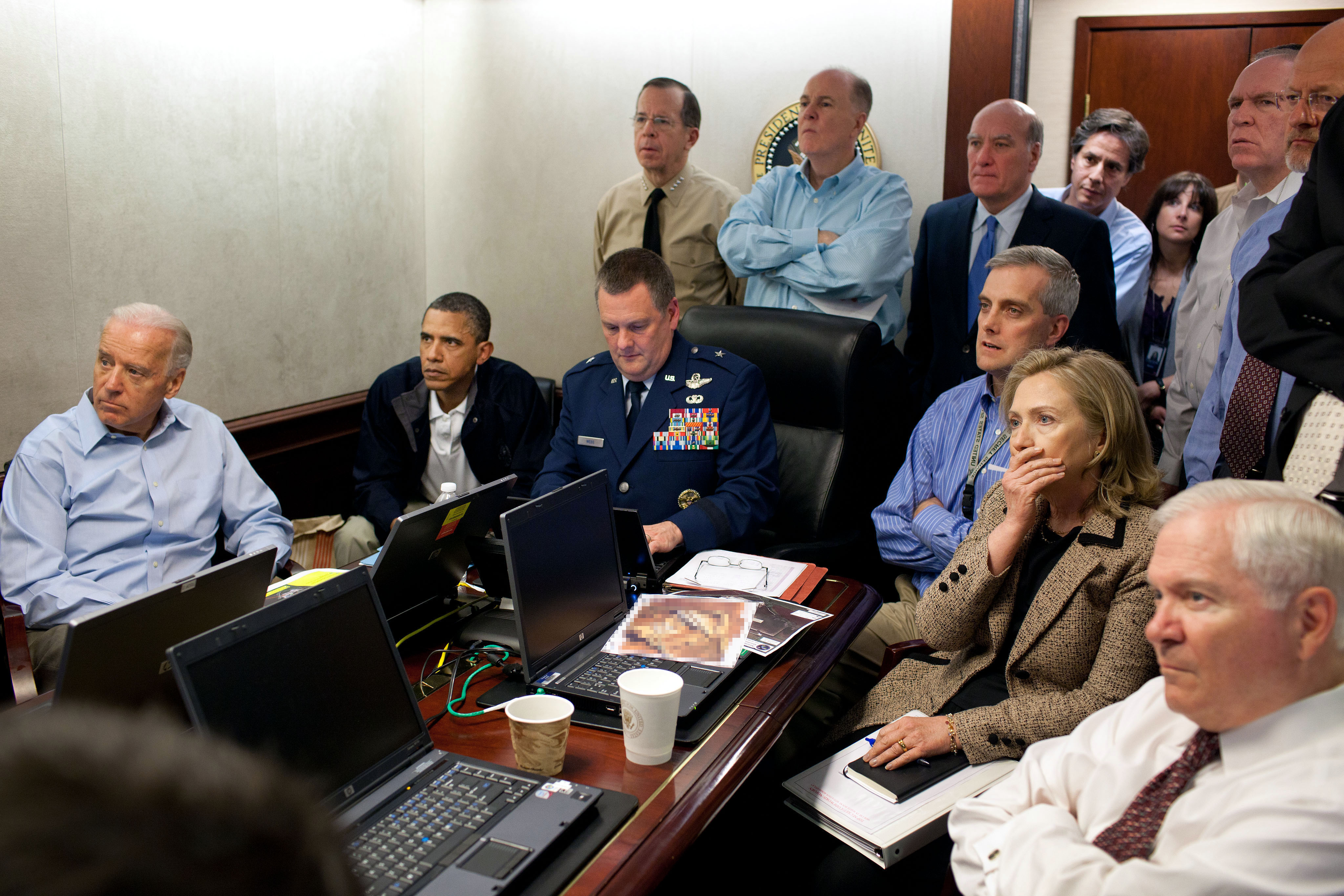 The Situation Room - Taken by Pete Souza on the afternoon of May 1, 2011, this image shows President Barack Obama and his national security team crowded into a small conference room in the West Wing’s Situation Room, receiving updates as US forces raided Osama bin Laden’s Pakistan compound and killed the terrorist leader. Photographs of bin Laden’s body have never been released, making Souza’s photo the only public image of one of the defining moments of the war on terror.
The Situation Room - Taken by Pete Souza on the afternoon of May 1, 2011, this image shows President Barack Obama and his national security team crowded into a small conference room in the West Wing’s Situation Room, receiving updates as US forces raided Osama bin Laden’s Pakistan compound and killed the terrorist leader. Photographs of bin Laden’s body have never been released, making Souza’s photo the only public image of one of the defining moments of the war on terror. -
2.
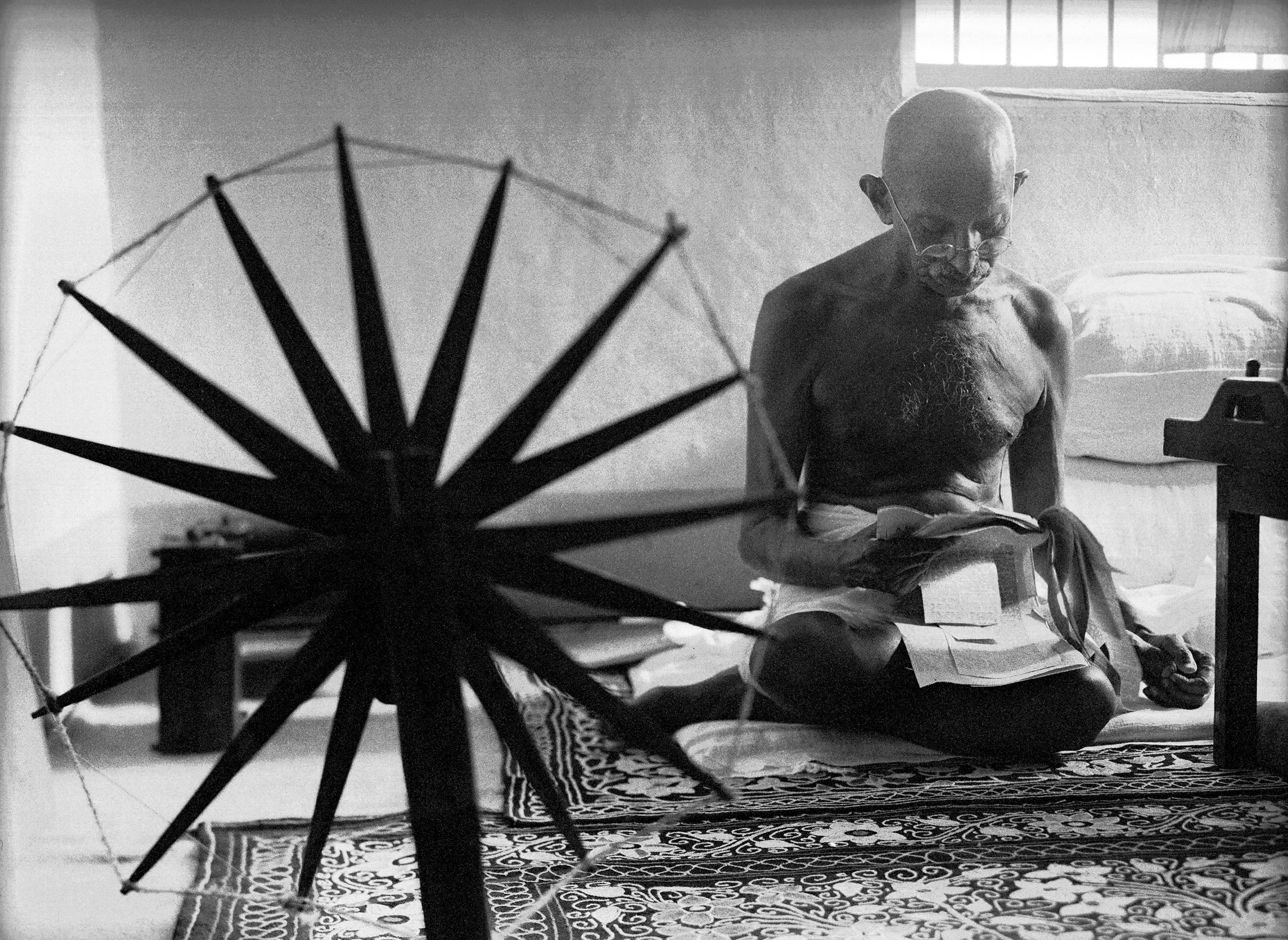 Gandhi and His Spinning Wheel - Perhaps the definitive photo of Mohandas Gandhi was taken by Margaret Bourke-White, LIFE magazine’s first female photographer. It depicts Gandhi reading the news next to his portable spinning wheel, which had become a potent exemplar of the campaign for independence after Ghandi had encouraged his countrymen to make their own homespun cloth instead of purchasing British goods.
Gandhi and His Spinning Wheel - Perhaps the definitive photo of Mohandas Gandhi was taken by Margaret Bourke-White, LIFE magazine’s first female photographer. It depicts Gandhi reading the news next to his portable spinning wheel, which had become a potent exemplar of the campaign for independence after Ghandi had encouraged his countrymen to make their own homespun cloth instead of purchasing British goods. -
3.
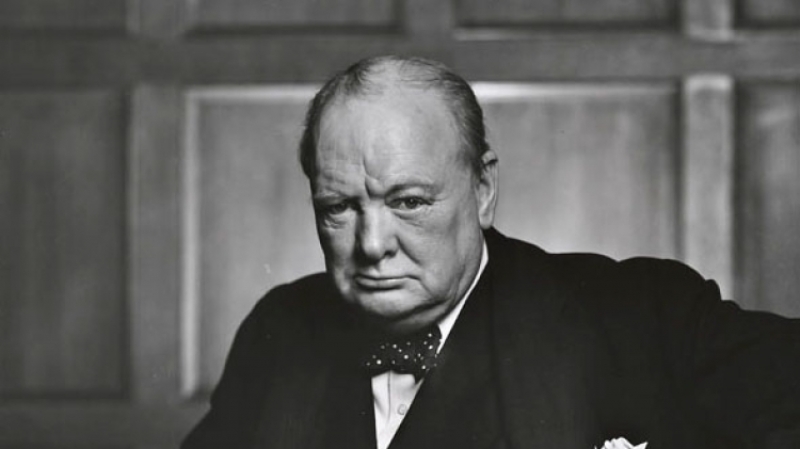 Winston Churchill, December 30, 1941 - One of the most iconic portraits of Churchill was taken by Yousuf Karsh after the prime minister had spoken to the Canadian Parliament in 1941. Churchill had lit a fresh cigar beforehand, and Karsh asked him to remove it for the photo. When he refused, Karsh stepped forward, said “Forgive me, sir,” and removed the cigar himself, resulting in that less-than-thrilled facial expression.
Winston Churchill, December 30, 1941 - One of the most iconic portraits of Churchill was taken by Yousuf Karsh after the prime minister had spoken to the Canadian Parliament in 1941. Churchill had lit a fresh cigar beforehand, and Karsh asked him to remove it for the photo. When he refused, Karsh stepped forward, said “Forgive me, sir,” and removed the cigar himself, resulting in that less-than-thrilled facial expression. -
4.
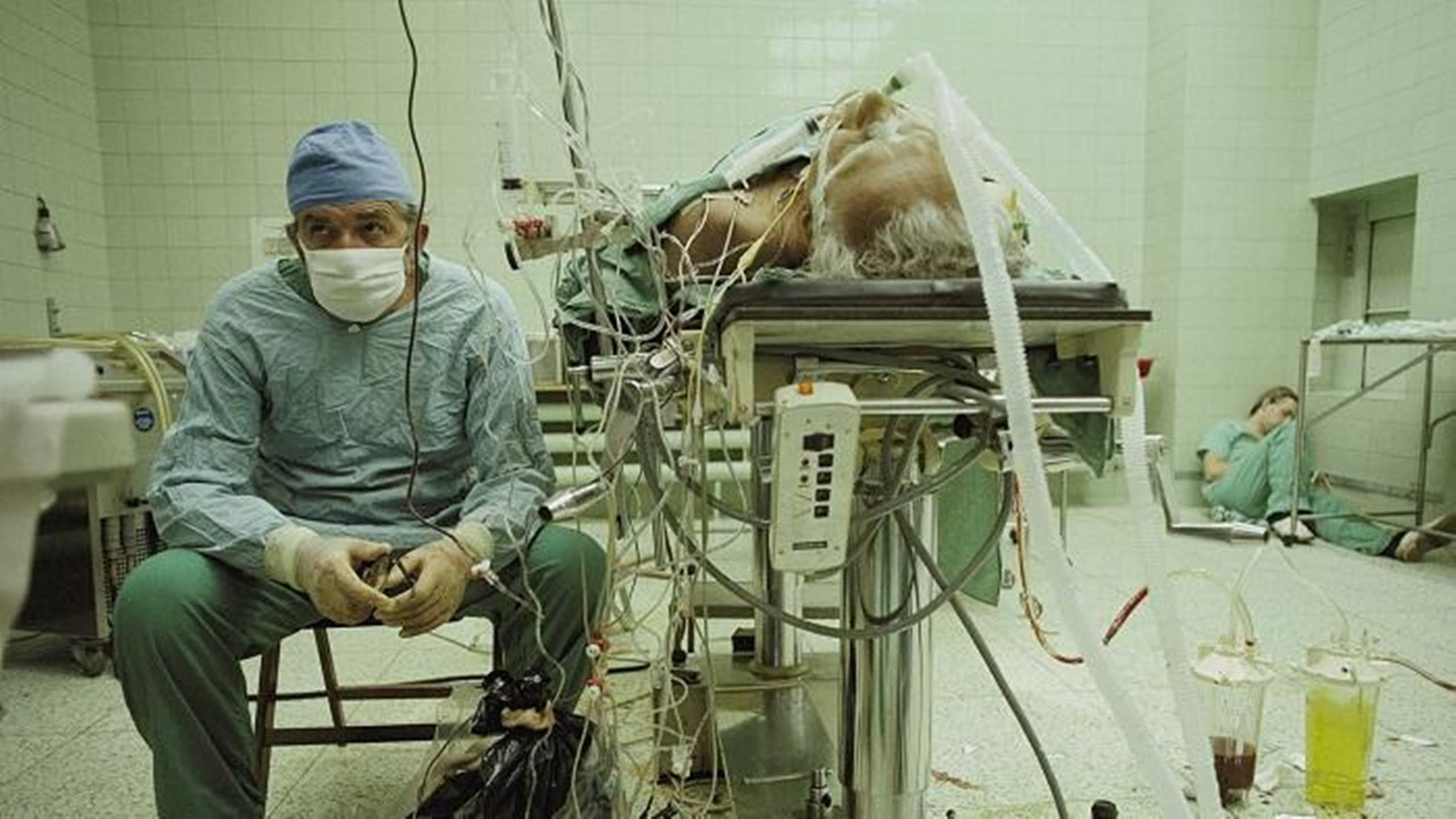 Anxious Eyes - Taken by James Stanfield in Poland, 1987, this picture depicts cardiac surgeon Zbigniew Religa tracking the vitals of a patient after a successful heart transplant while his assistant rests in the corner. The surgery had taken 23 hours and had used very outdated equipment.
Anxious Eyes - Taken by James Stanfield in Poland, 1987, this picture depicts cardiac surgeon Zbigniew Religa tracking the vitals of a patient after a successful heart transplant while his assistant rests in the corner. The surgery had taken 23 hours and had used very outdated equipment. -
5.
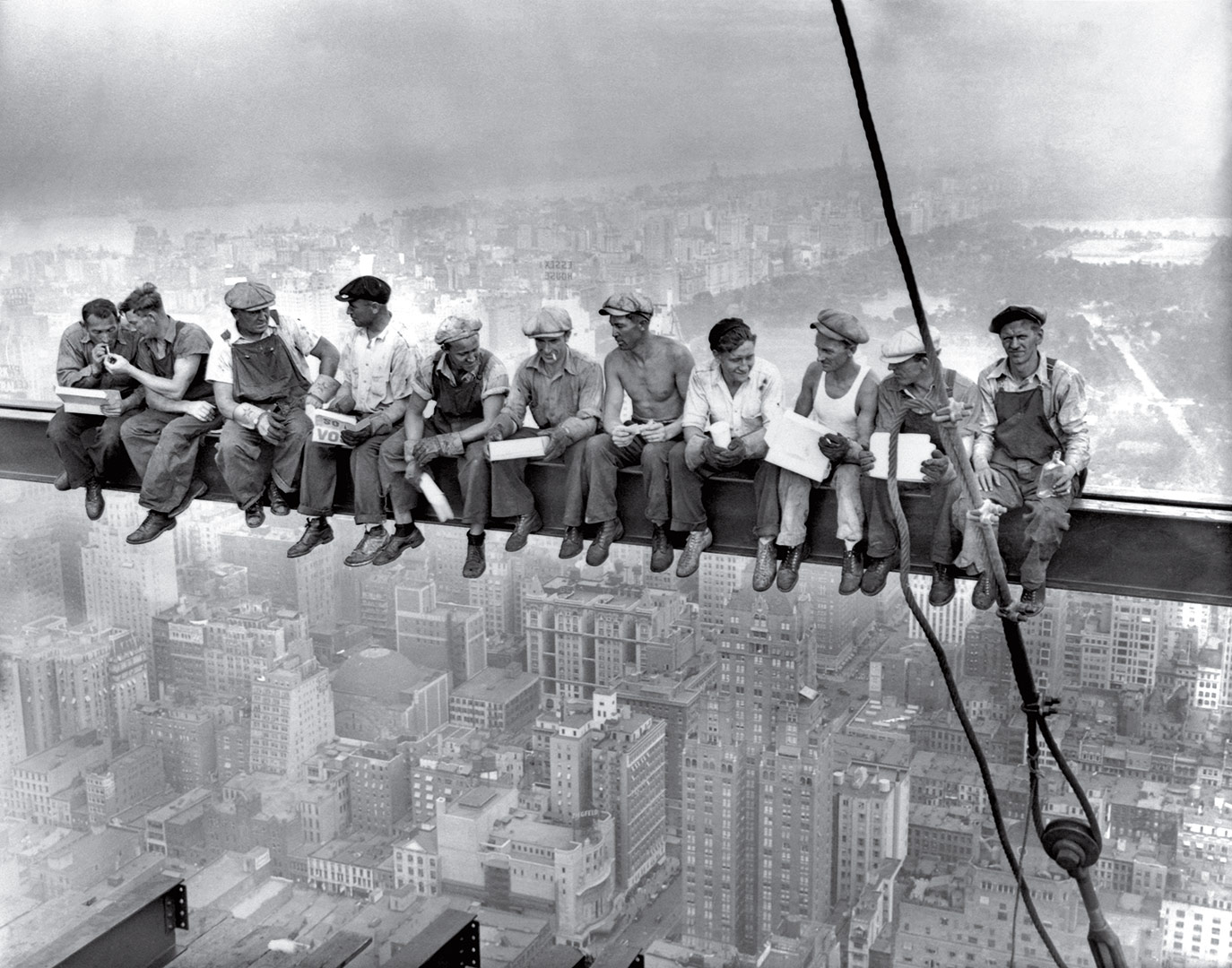 Lunch Atop a Skyscraper - This famous picture, depicting construction workers having lunch on a girder on top of a skyscraper in Rockefeller Center, New York, is actually a staged publicity photo intended to drum up excitement for the project’s impending completion (I guess construction workers don’t really eat their lunch on steel girders). Still, they really are dangling their feet 850 feet above the ground, harness-free.
Lunch Atop a Skyscraper - This famous picture, depicting construction workers having lunch on a girder on top of a skyscraper in Rockefeller Center, New York, is actually a staged publicity photo intended to drum up excitement for the project’s impending completion (I guess construction workers don’t really eat their lunch on steel girders). Still, they really are dangling their feet 850 feet above the ground, harness-free. -
6.
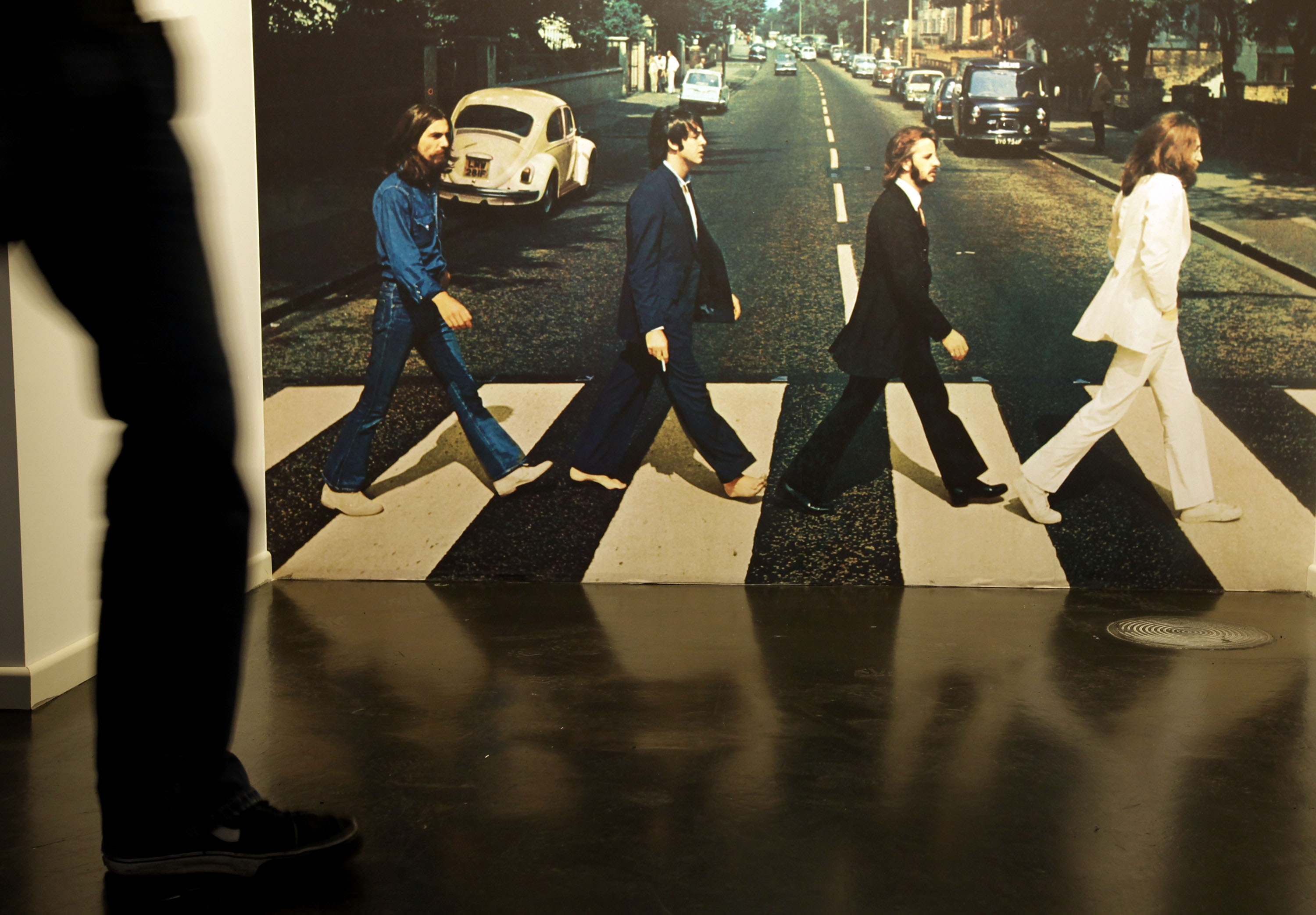 Abbey Road - The Abbey Road album cover is possibly the most famous photo of the Beatles there is, but it was actually doctored a little. US poster companies removed the cigarette from Paul’s hand—without his or Apple Records’ (who own the rights to the image) permission.
Abbey Road - The Abbey Road album cover is possibly the most famous photo of the Beatles there is, but it was actually doctored a little. US poster companies removed the cigarette from Paul’s hand—without his or Apple Records’ (who own the rights to the image) permission. -
7.
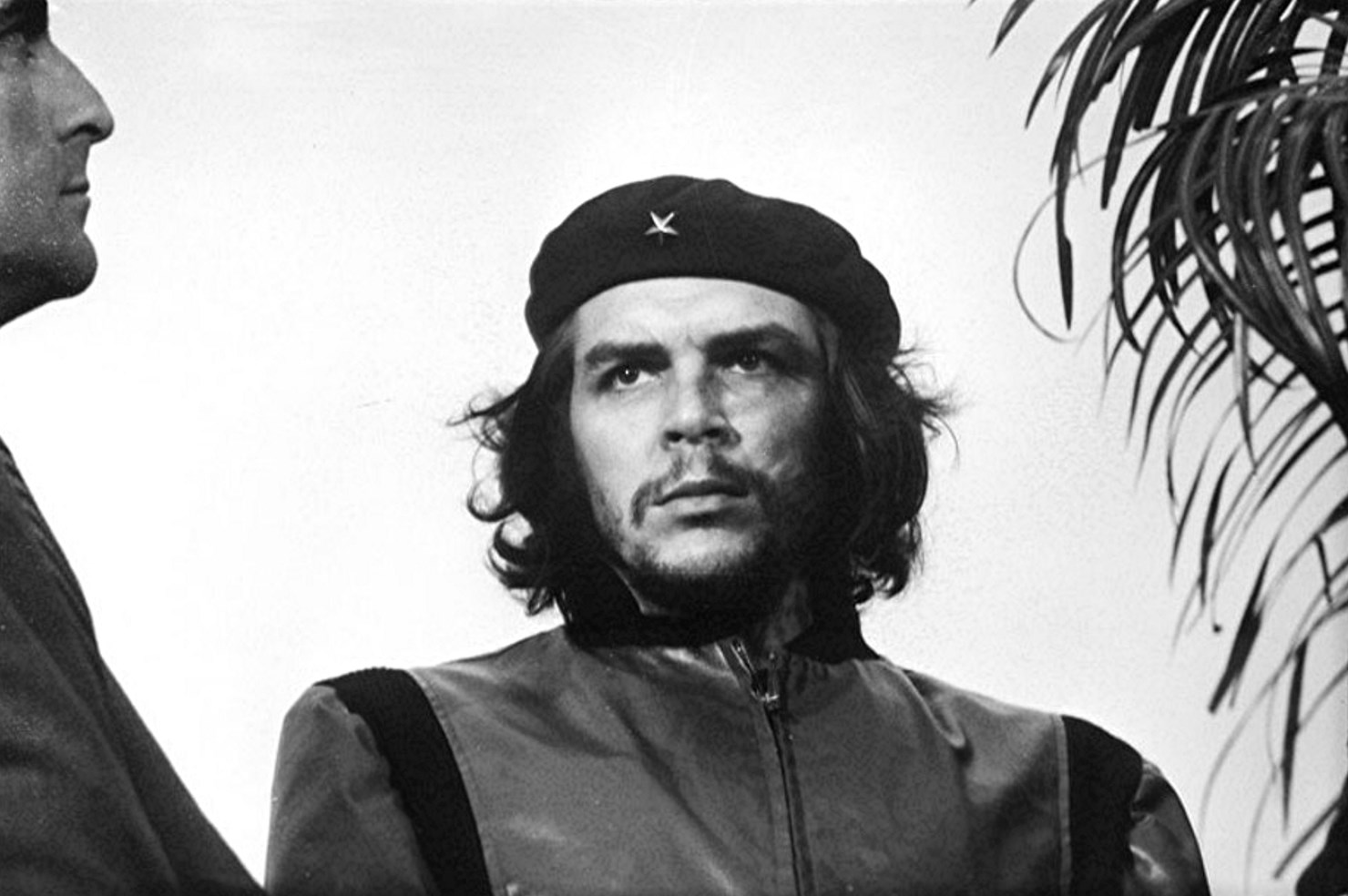 Guerrillero Heroico - This photo of Cuban revolutionary Che Guevara is one of the most reproduced and recognizable images of all time, but when it was taken it was basically an afterthought. Photographer Alberto Korda had been in Cuba to cover the funeral of the victims of a ship explosion in Havana Harbor, and he focused on Fidel Castro and his indictment of the US in the wake of the tragedy. He shot two photos of Guevara, Castro’s young ally, but they went unpublished by his newspaper. It wasn’t until after Guevara was killed in Bolivia almost seven years later, when he became embraced as a martyr for the revolution, that Korda’s image of him became the revolution’s most persistent symbol.
Guerrillero Heroico - This photo of Cuban revolutionary Che Guevara is one of the most reproduced and recognizable images of all time, but when it was taken it was basically an afterthought. Photographer Alberto Korda had been in Cuba to cover the funeral of the victims of a ship explosion in Havana Harbor, and he focused on Fidel Castro and his indictment of the US in the wake of the tragedy. He shot two photos of Guevara, Castro’s young ally, but they went unpublished by his newspaper. It wasn’t until after Guevara was killed in Bolivia almost seven years later, when he became embraced as a martyr for the revolution, that Korda’s image of him became the revolution’s most persistent symbol. -
8.
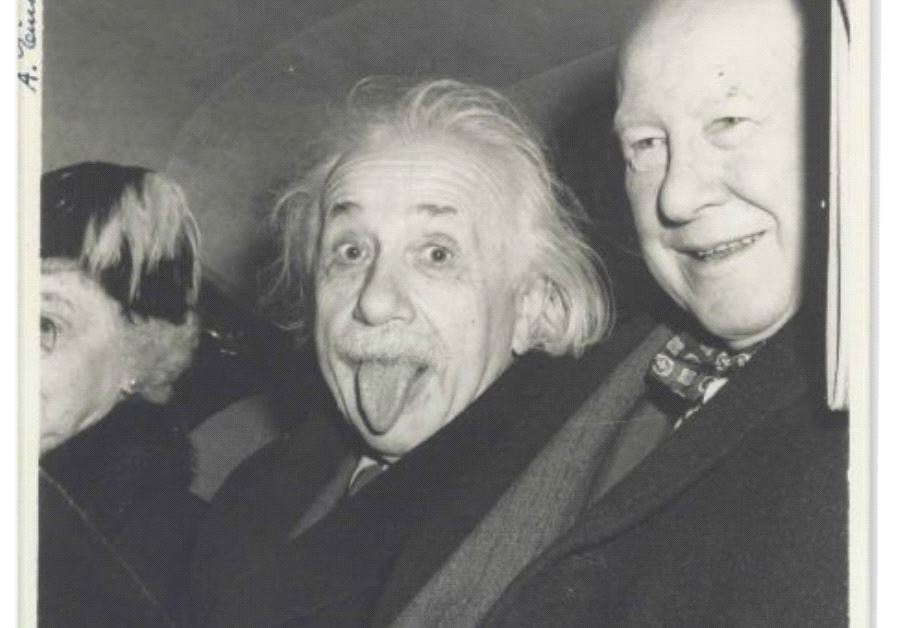 Einstein’s Birthday - On his 72nd birthday, photographer Arthur Sasse tried to get Einstein to smile for the camera. Tired of smiling for photographers all day, Einstein stuck out his tongue instead.
Einstein’s Birthday - On his 72nd birthday, photographer Arthur Sasse tried to get Einstein to smile for the camera. Tired of smiling for photographers all day, Einstein stuck out his tongue instead. -
9.
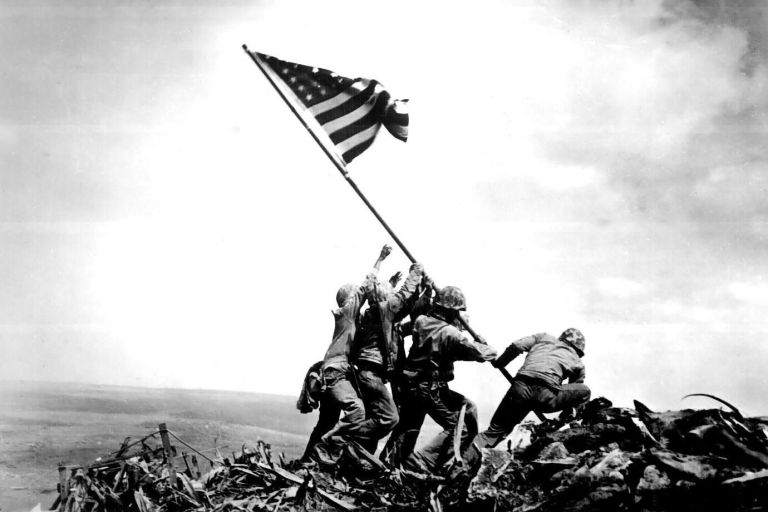 Raising the Flag on Iwo Jima - On February 23, 1945, Joe Rosenthal shot this photo of five Marines and one Navy corpsman raising a U.S. flag on Mt. Suribachi, on the fifth day of a battle that claimed the lives of 6,800 Americans and 21,000 Japanese. A smaller flag was initially raised, but a commander called for a larger, more easily-visible replacement to both inspire his men and demoralise his opponents. Rosenthal’s photo shows this second raising, which became a patriotic symbol of unity and won Rosenthal a Pulitzer Prize.
Raising the Flag on Iwo Jima - On February 23, 1945, Joe Rosenthal shot this photo of five Marines and one Navy corpsman raising a U.S. flag on Mt. Suribachi, on the fifth day of a battle that claimed the lives of 6,800 Americans and 21,000 Japanese. A smaller flag was initially raised, but a commander called for a larger, more easily-visible replacement to both inspire his men and demoralise his opponents. Rosenthal’s photo shows this second raising, which became a patriotic symbol of unity and won Rosenthal a Pulitzer Prize. -
10.
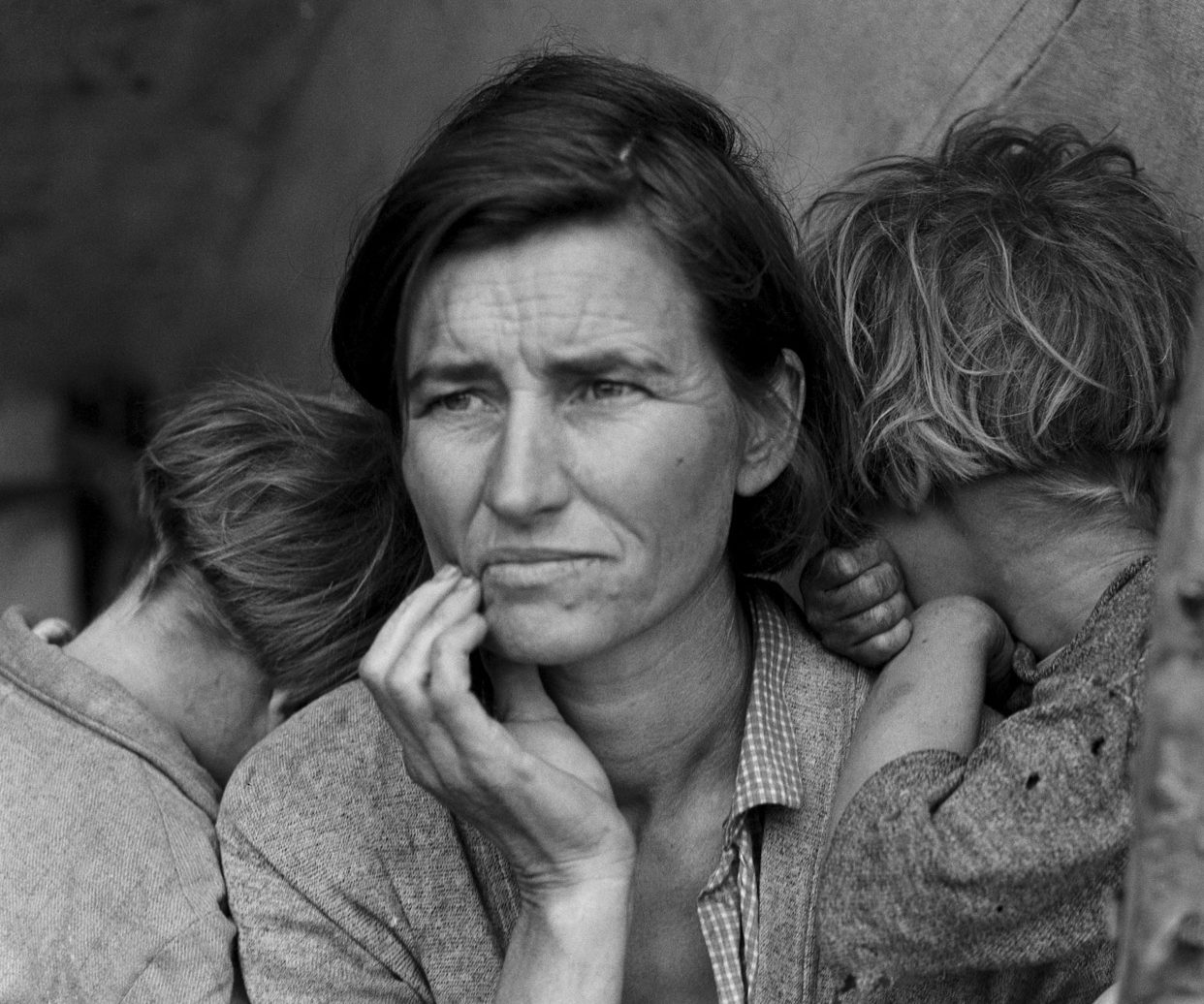 Migrant Mother - This image of an impoverished woman with two of her seven children at a pea-pickers camp in Nipomo, California was shot by photographer Dorothea Lange in 1936. The photo was taken to document the plight of migrant agricultural workers and was published in newspapers, prompting the government to deliver food aid to the Nipomo camp. The woman, 32 years old at the time and identified decades later as Florence Owens Thompson, was critical of Lange and stated that she felt the photo was exploitative and wished it hadn’t been taken. She also expressed regret she hadn’t made any money from it. Thompson died at age 80 in 1983.
Migrant Mother - This image of an impoverished woman with two of her seven children at a pea-pickers camp in Nipomo, California was shot by photographer Dorothea Lange in 1936. The photo was taken to document the plight of migrant agricultural workers and was published in newspapers, prompting the government to deliver food aid to the Nipomo camp. The woman, 32 years old at the time and identified decades later as Florence Owens Thompson, was critical of Lange and stated that she felt the photo was exploitative and wished it hadn’t been taken. She also expressed regret she hadn’t made any money from it. Thompson died at age 80 in 1983. -
11.
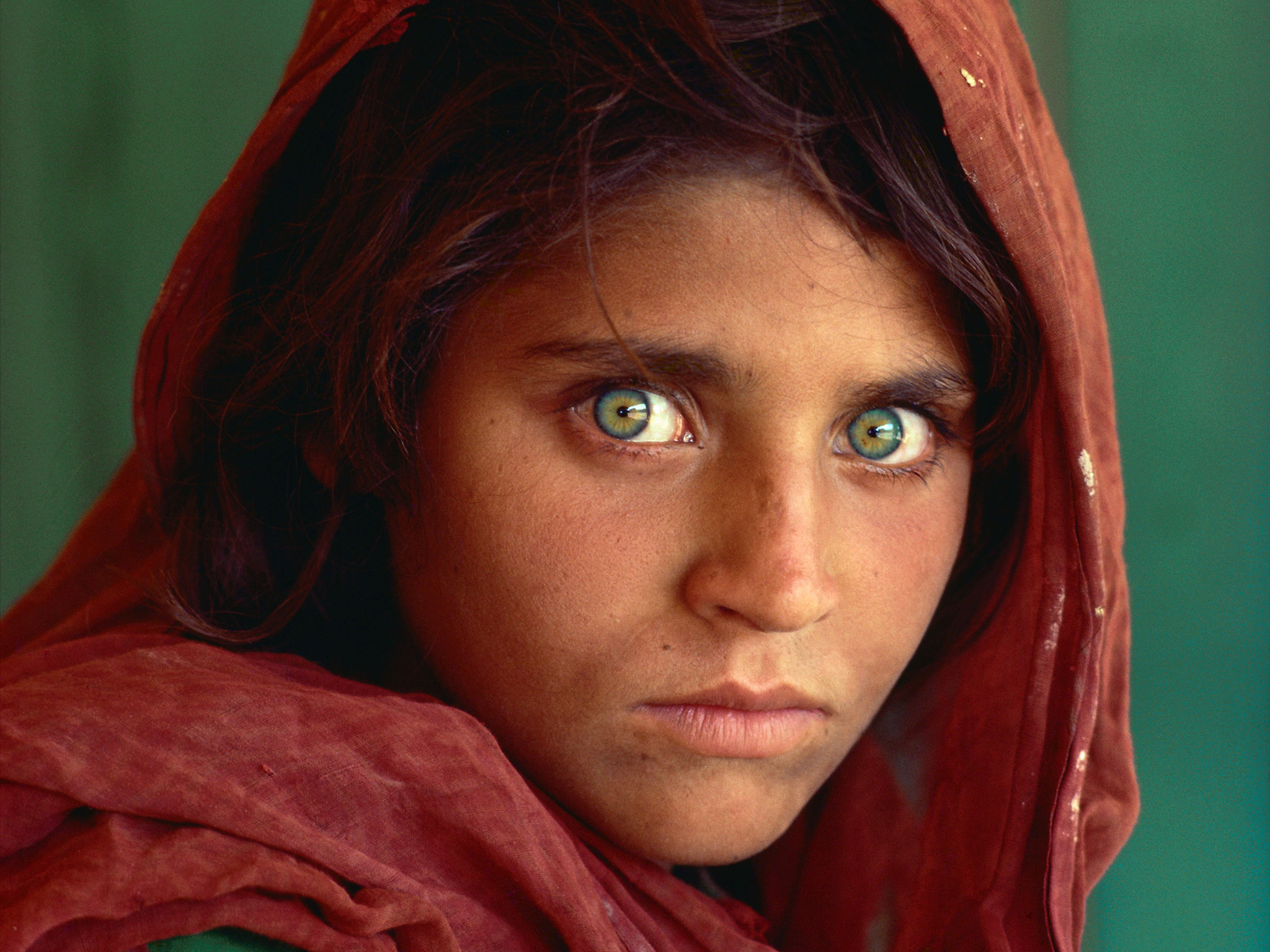 Afghan Girl - Taken by Steve McCurry during the Soviet occupation of Afghanistan, this transfixing image depicts a refugee from the war and was used for the cover the June 1985 issue of National Geographic. The subject was only identified 17 years later as Sharbat Gula, and she had never actually seen her iconic portrait before McCurry managed to track her down in January 2002.
Afghan Girl - Taken by Steve McCurry during the Soviet occupation of Afghanistan, this transfixing image depicts a refugee from the war and was used for the cover the June 1985 issue of National Geographic. The subject was only identified 17 years later as Sharbat Gula, and she had never actually seen her iconic portrait before McCurry managed to track her down in January 2002. -
12.
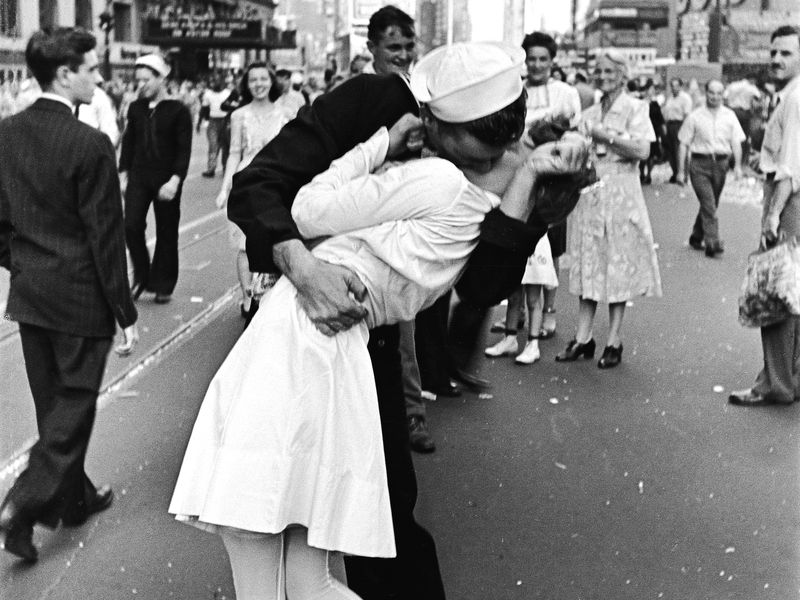 V-J Day Kiss - Taken on V-J Day on August 14, 1945 by photographer Alfred Eisentaedt and published in LIFE magazine, this infamous picture of a World War II sailor kissing a nurse captured the jubilance people felt upon the war’s end and almost instantly became a cultural icon. The identities of the subjects remained a mystery for decades until they were eventually determined to be George Mendonsa and Greta Friedman. The two didn’t know each other (Eisentaedt later said of that day “There were thousands of people milling around…everybody was kissing each other”), and Mendonsa’s wife Rita can actually be seen smiling in the background of the photo. Many people have come to view the picture as insensitively depicting sexual assault, and not something to be celebrated. Friedman, who died at the age of 92 in 2016, rejected this, stating there was “no way there was anything bad about it.”
V-J Day Kiss - Taken on V-J Day on August 14, 1945 by photographer Alfred Eisentaedt and published in LIFE magazine, this infamous picture of a World War II sailor kissing a nurse captured the jubilance people felt upon the war’s end and almost instantly became a cultural icon. The identities of the subjects remained a mystery for decades until they were eventually determined to be George Mendonsa and Greta Friedman. The two didn’t know each other (Eisentaedt later said of that day “There were thousands of people milling around…everybody was kissing each other”), and Mendonsa’s wife Rita can actually be seen smiling in the background of the photo. Many people have come to view the picture as insensitively depicting sexual assault, and not something to be celebrated. Friedman, who died at the age of 92 in 2016, rejected this, stating there was “no way there was anything bad about it.” -
13.
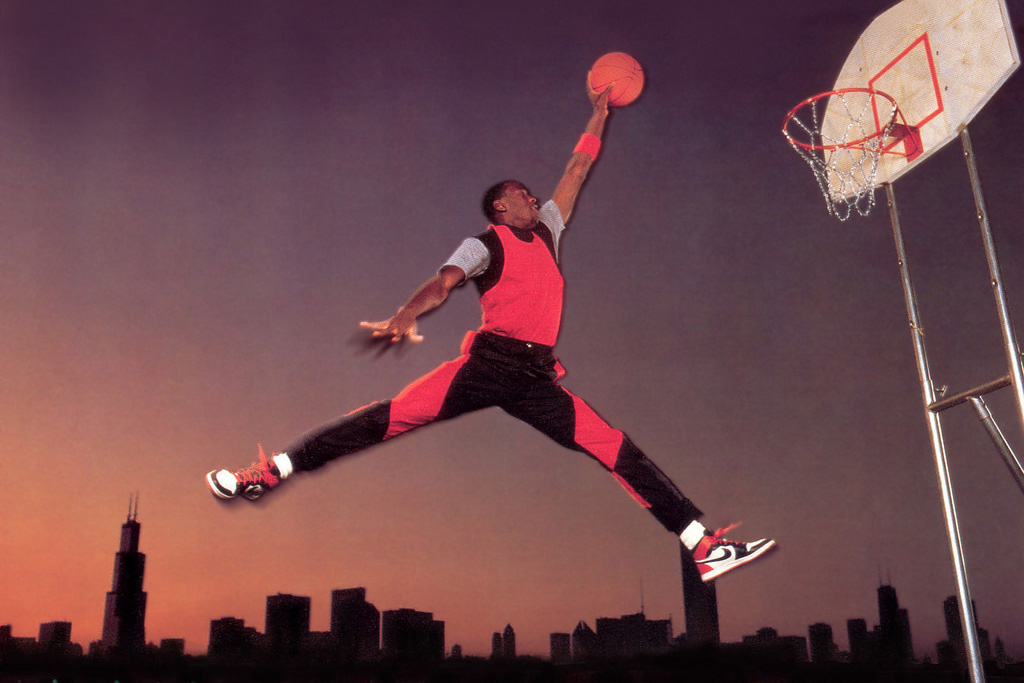 Michael Jordan - Jacobus “Co” Rentmeester shot Michael Jordan in his famous “Jumpman” pose for LIFE in 1984, maybe the most famous silhouette ever photographed. The pose was staged and not actually consistent with Jordan’s regular dunking style. Rentmeester simply had Jordan leap up on the spot and adopt a pose inspired by a ballet technique known as a “grand jeté” to make it appear as if he was dunking. Nike paid Rentmeester $15,000 for a two year license to use the image, but they continued to use it well beyond that and it eventually became one of the most popular commercial logos of all time. Rentmeester sued Nike for copyright infringement, but the suit was dismissed in June 2015.
Michael Jordan - Jacobus “Co” Rentmeester shot Michael Jordan in his famous “Jumpman” pose for LIFE in 1984, maybe the most famous silhouette ever photographed. The pose was staged and not actually consistent with Jordan’s regular dunking style. Rentmeester simply had Jordan leap up on the spot and adopt a pose inspired by a ballet technique known as a “grand jeté” to make it appear as if he was dunking. Nike paid Rentmeester $15,000 for a two year license to use the image, but they continued to use it well beyond that and it eventually became one of the most popular commercial logos of all time. Rentmeester sued Nike for copyright infringement, but the suit was dismissed in June 2015. -
14.
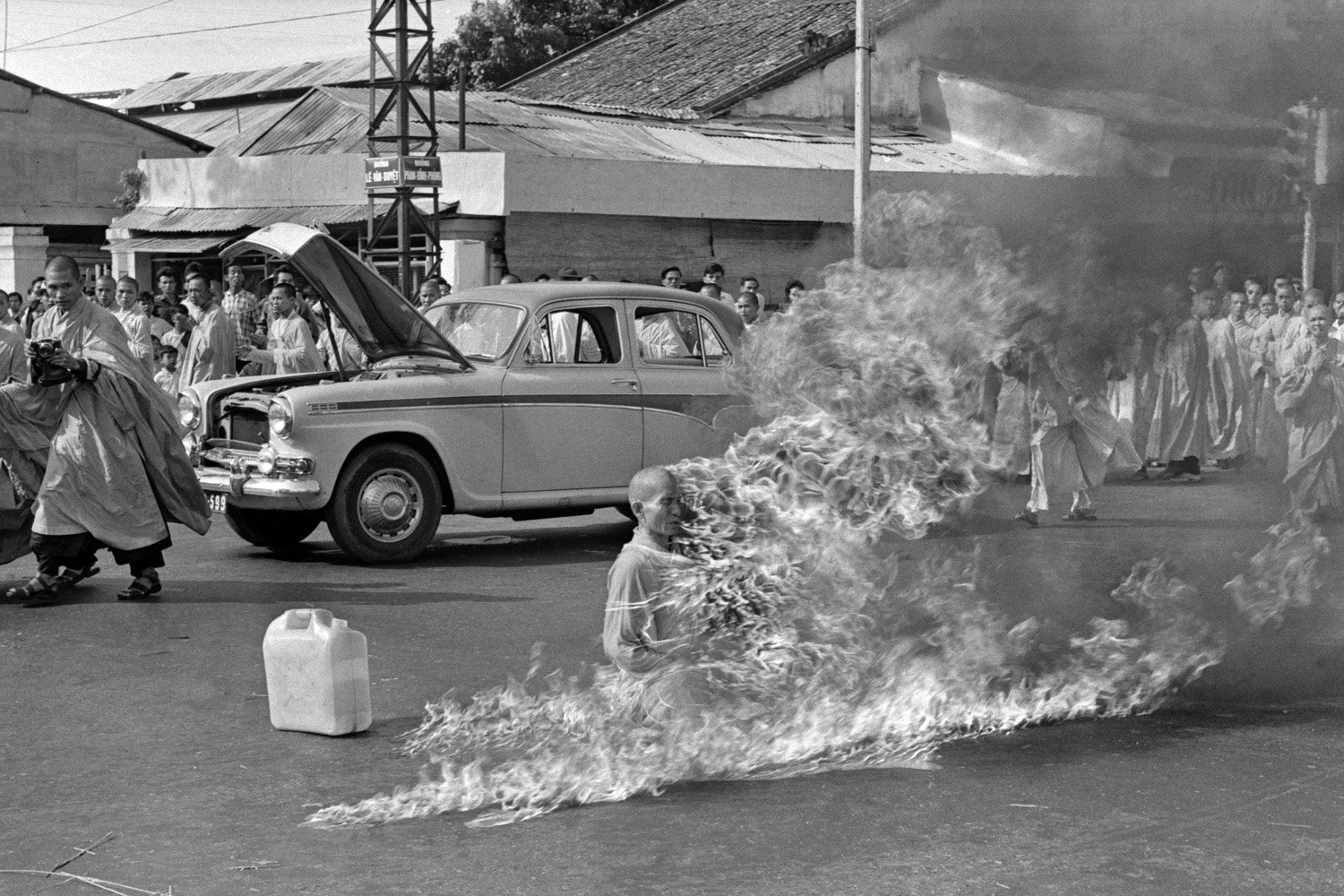 The Burning Monk - Malcolm Browne’s 1963 photo of a Buddhist monk calmly setting himself on fire on the streets of Saigon to protest against the U.S.-supported South Vietnamese government is still considered one of the most striking and iconic images of the Vietnam war. It was published in newspapers around the world the next day, and prompted president John F. Kennedy to declare “No news picture in history has generated so much emotion around the world as that one.” The photo contributed significantly to the direction of the war, inciting the U.S to put pressure on the South Vietnam regime to end persecution of Buddhists.
The Burning Monk - Malcolm Browne’s 1963 photo of a Buddhist monk calmly setting himself on fire on the streets of Saigon to protest against the U.S.-supported South Vietnamese government is still considered one of the most striking and iconic images of the Vietnam war. It was published in newspapers around the world the next day, and prompted president John F. Kennedy to declare “No news picture in history has generated so much emotion around the world as that one.” The photo contributed significantly to the direction of the war, inciting the U.S to put pressure on the South Vietnam regime to end persecution of Buddhists. -
15.
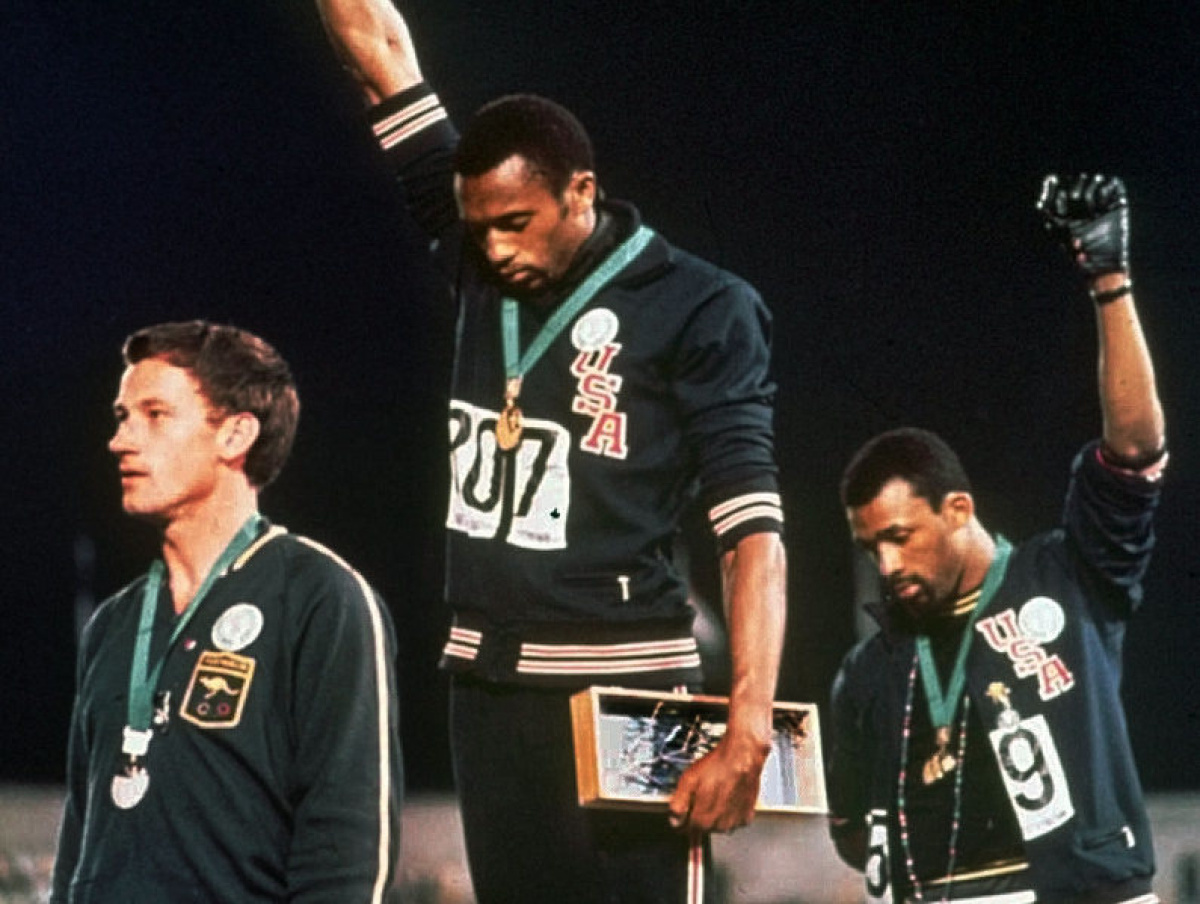 Black Power Salute - When African-American Olympic sprinters Tommie Smith and John Carlos stood atop the medal podium in Mexico City, 1968, heads bowed and black-gloved fists raised during the playing of the national anthem, many were outraged but many more were thrilled and inspired by their Black Power salute. John Dominis’ photo endures to this day as a symbol of expressed disillusionment with the promise of a nation. In the photo, Smith stands in black socks with his running shoes off in a gesture meant to symbolize black poverty. Australian silver medalist Peter Norman stood and displayed solidarity with them, wearing an Olympic Project for Human Rights badge during the ceremony. In 2006, both Smith and Carlos were pallbearers at Norman’s funeral.
Black Power Salute - When African-American Olympic sprinters Tommie Smith and John Carlos stood atop the medal podium in Mexico City, 1968, heads bowed and black-gloved fists raised during the playing of the national anthem, many were outraged but many more were thrilled and inspired by their Black Power salute. John Dominis’ photo endures to this day as a symbol of expressed disillusionment with the promise of a nation. In the photo, Smith stands in black socks with his running shoes off in a gesture meant to symbolize black poverty. Australian silver medalist Peter Norman stood and displayed solidarity with them, wearing an Olympic Project for Human Rights badge during the ceremony. In 2006, both Smith and Carlos were pallbearers at Norman’s funeral. -
16.
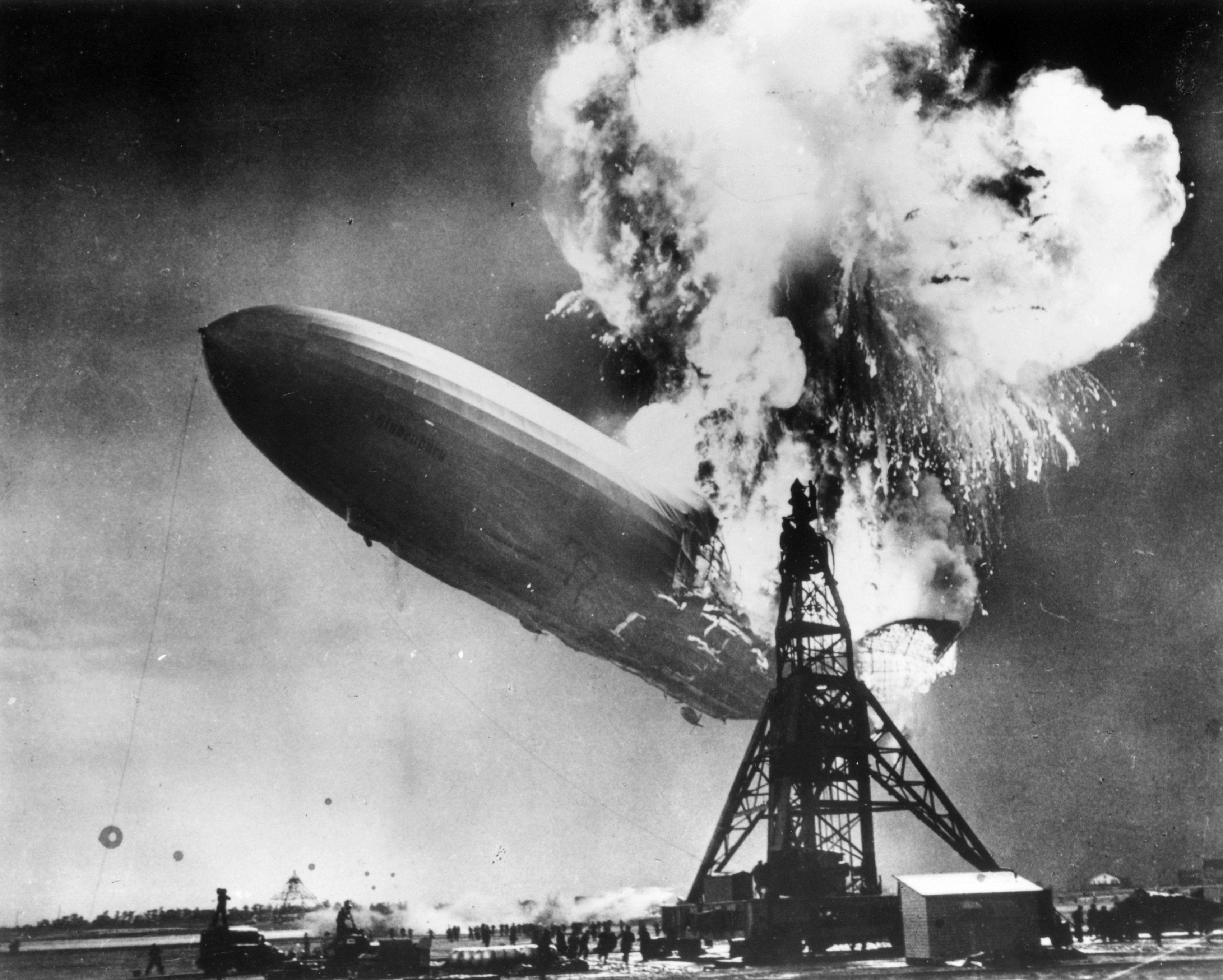 The Hindenburg Disaster - Sam Shere was one of nearly two dozen photographers who scrambled to document the crash of the Hindenburg Zeppelin that killed 36 people on May 6, 1937. But it’s his image, with its grandeur and palpable terror, that has endured over the other photographs. Published on front pages around the world and used on the cover of a Led Zeppelin album decades later, the disaster and the press coverage surrounding it brought the golden age of the airships to a definitive end.
The Hindenburg Disaster - Sam Shere was one of nearly two dozen photographers who scrambled to document the crash of the Hindenburg Zeppelin that killed 36 people on May 6, 1937. But it’s his image, with its grandeur and palpable terror, that has endured over the other photographs. Published on front pages around the world and used on the cover of a Led Zeppelin album decades later, the disaster and the press coverage surrounding it brought the golden age of the airships to a definitive end. -
17.
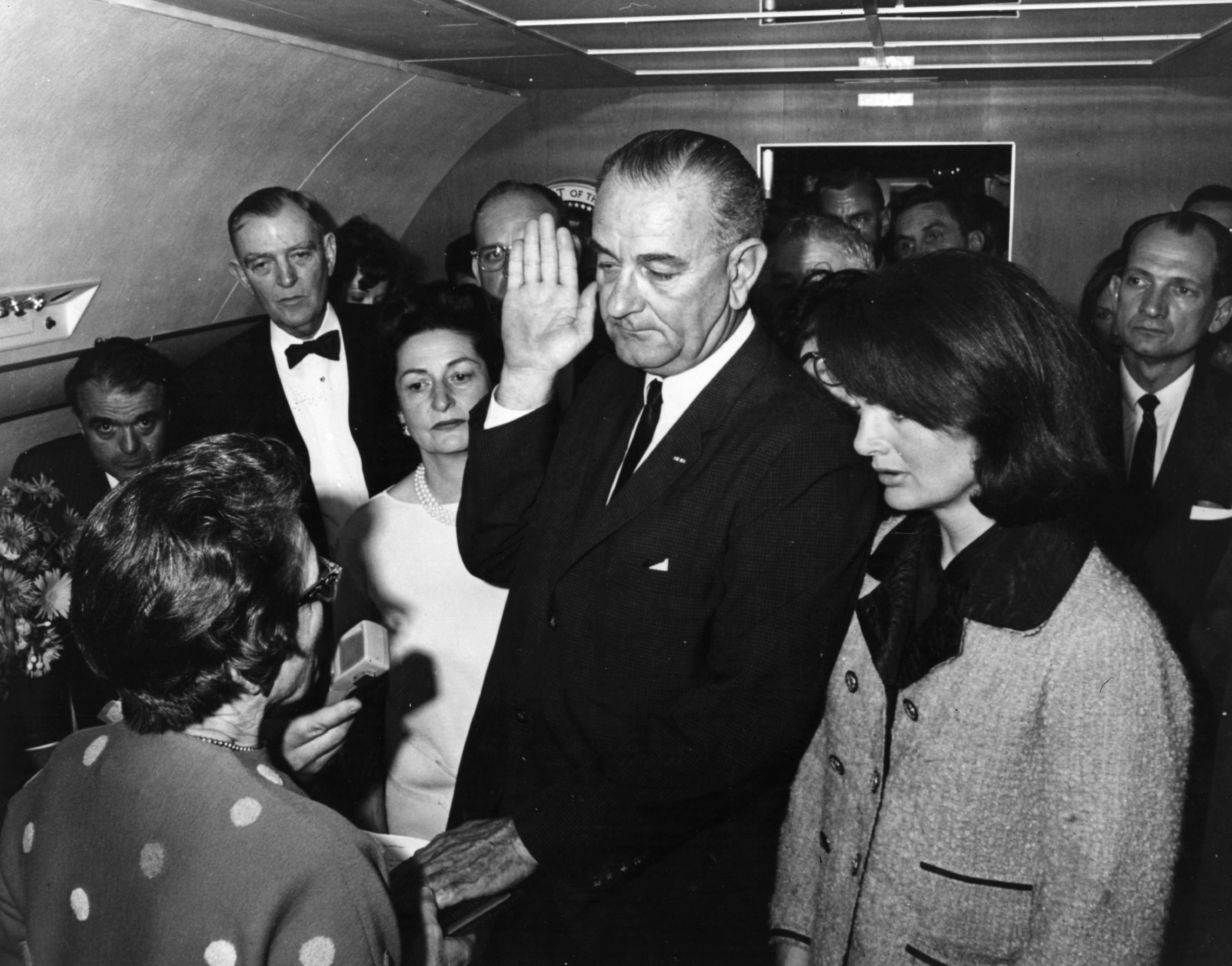 Lyndon Johnson, Air Force One - Former army photographer Cecil Stoughton, the first person to hold the post of White House photographer, took this historic photo of Judge Sarah Hughes administering the oath of office to a solemn Lyndon Johnson mere hours after President John F. Kennedy was assassinated on November 22, 1963. Johnson is surrounded by a group of staffers, as well as his wife and a bewildered-looking Jaqueline Kennedy, who is still wearing the pink Chanel suit she had on when her husband was shot. The only photographer on the plane when Johnson was inaugurated, Stoughton’s camera initially malfunctioned and it appeared there wouldn’t be any photographic record of the event. Thankfully, he quickly fixed the problem and was able to document it.
Lyndon Johnson, Air Force One - Former army photographer Cecil Stoughton, the first person to hold the post of White House photographer, took this historic photo of Judge Sarah Hughes administering the oath of office to a solemn Lyndon Johnson mere hours after President John F. Kennedy was assassinated on November 22, 1963. Johnson is surrounded by a group of staffers, as well as his wife and a bewildered-looking Jaqueline Kennedy, who is still wearing the pink Chanel suit she had on when her husband was shot. The only photographer on the plane when Johnson was inaugurated, Stoughton’s camera initially malfunctioned and it appeared there wouldn’t be any photographic record of the event. Thankfully, he quickly fixed the problem and was able to document it. -
18.
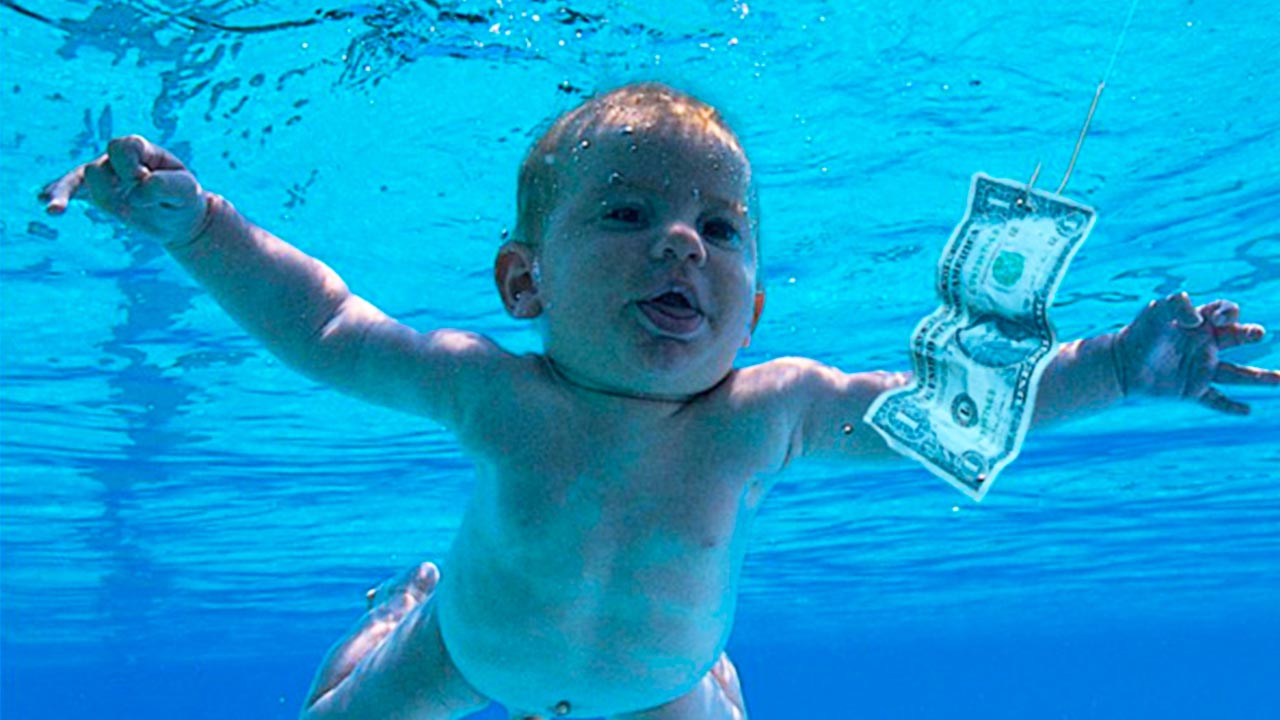 Nirvana’s Swimming Baby - Snapped by photographer Kirk Weddle, the baby depicted on the cover of Nirvana’s influential Nevermind album was the four-month-old son of Weddle’s friends. And he’s not actually swimming. As Weddle explains “The mom was on my left, and blew a puff of air into the child’s face. Then we dunked him in and, bang bang, pulled him out. We did it twice and that was it.” Anything for rock n’roll.
Nirvana’s Swimming Baby - Snapped by photographer Kirk Weddle, the baby depicted on the cover of Nirvana’s influential Nevermind album was the four-month-old son of Weddle’s friends. And he’s not actually swimming. As Weddle explains “The mom was on my left, and blew a puff of air into the child’s face. Then we dunked him in and, bang bang, pulled him out. We did it twice and that was it.” Anything for rock n’roll. -
19.
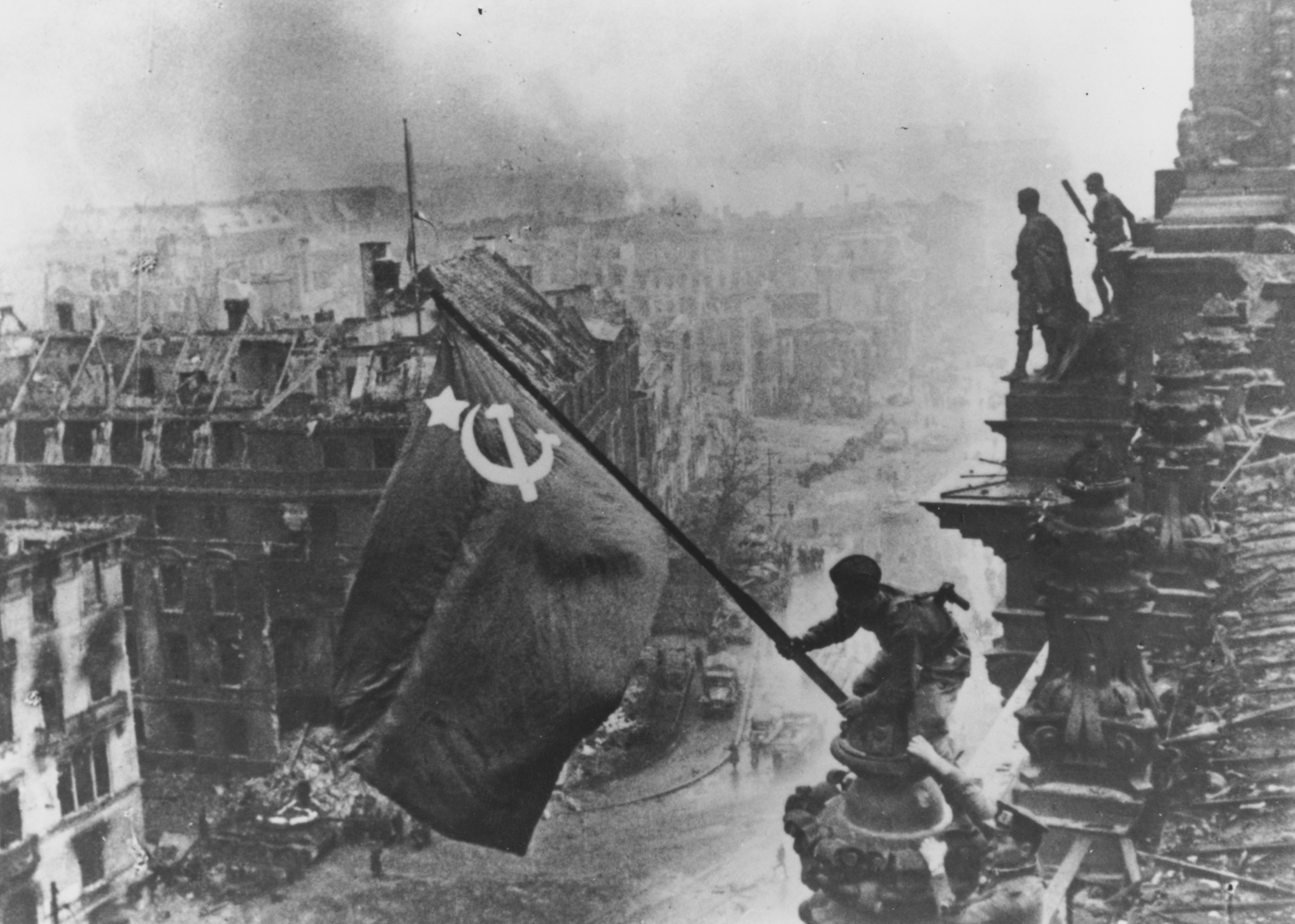 Raising a Flag over the Reichstag - Yevgeny Khaldei photographed this historic image of a Soviet soldier heroically waving the red flag above the Reichstag on May 2, 1945. The image was altered before being published, however; a second watch on the wrist of the Russian soldier was removed to conceal the fact that the soldiers had been looting.
Raising a Flag over the Reichstag - Yevgeny Khaldei photographed this historic image of a Soviet soldier heroically waving the red flag above the Reichstag on May 2, 1945. The image was altered before being published, however; a second watch on the wrist of the Russian soldier was removed to conceal the fact that the soldiers had been looting. -
20.
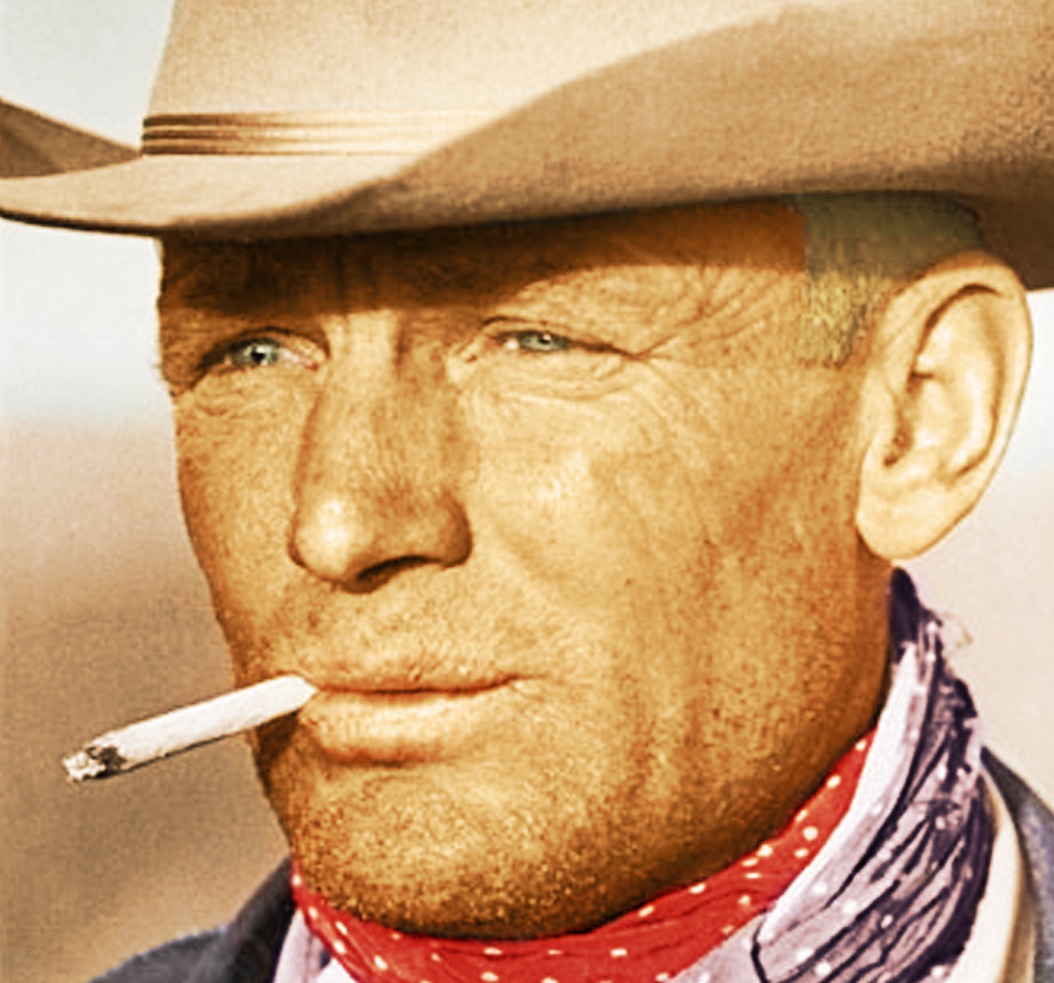 The (Original) Marlboro Man - Clarence Hailey Long, the original “Marlboro Man,” was a 39 year old ranch foreman whose picture was taken by Leonard McCombe for a 1949 LIFE magazine series about ranching. The tobacco company Philip Morris was seeking a new image for the Marlboro brand, which had been introduced as a woman’s cigarette in 1924, and Long’s image inspired execs to use him in a new ad campaign that propelled Marlboro to the top of the worldwide cigarette market.
The (Original) Marlboro Man - Clarence Hailey Long, the original “Marlboro Man,” was a 39 year old ranch foreman whose picture was taken by Leonard McCombe for a 1949 LIFE magazine series about ranching. The tobacco company Philip Morris was seeking a new image for the Marlboro brand, which had been introduced as a woman’s cigarette in 1924, and Long’s image inspired execs to use him in a new ad campaign that propelled Marlboro to the top of the worldwide cigarette market. -
21.
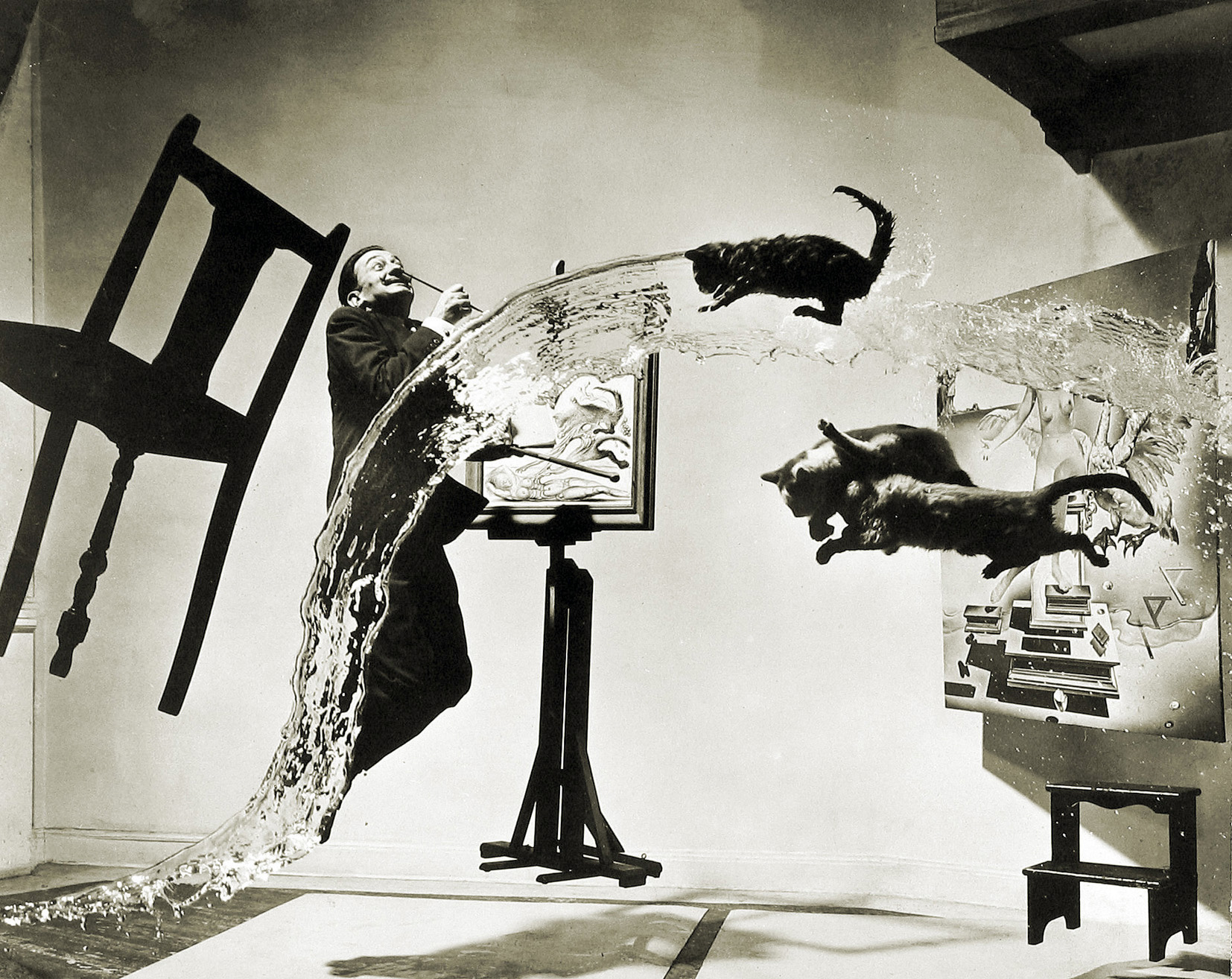 Dali Atomicus - Capturing the essence of his subject as accurately as one could ever hope, it took photographer Philippe Halsman six hours, 28 takes, and a roomful of assistants throwing buckets of water at three cats across the room before he’d gotten what he deemed to be the perfect photo of Salvador Dali.
Dali Atomicus - Capturing the essence of his subject as accurately as one could ever hope, it took photographer Philippe Halsman six hours, 28 takes, and a roomful of assistants throwing buckets of water at three cats across the room before he’d gotten what he deemed to be the perfect photo of Salvador Dali. -
22.
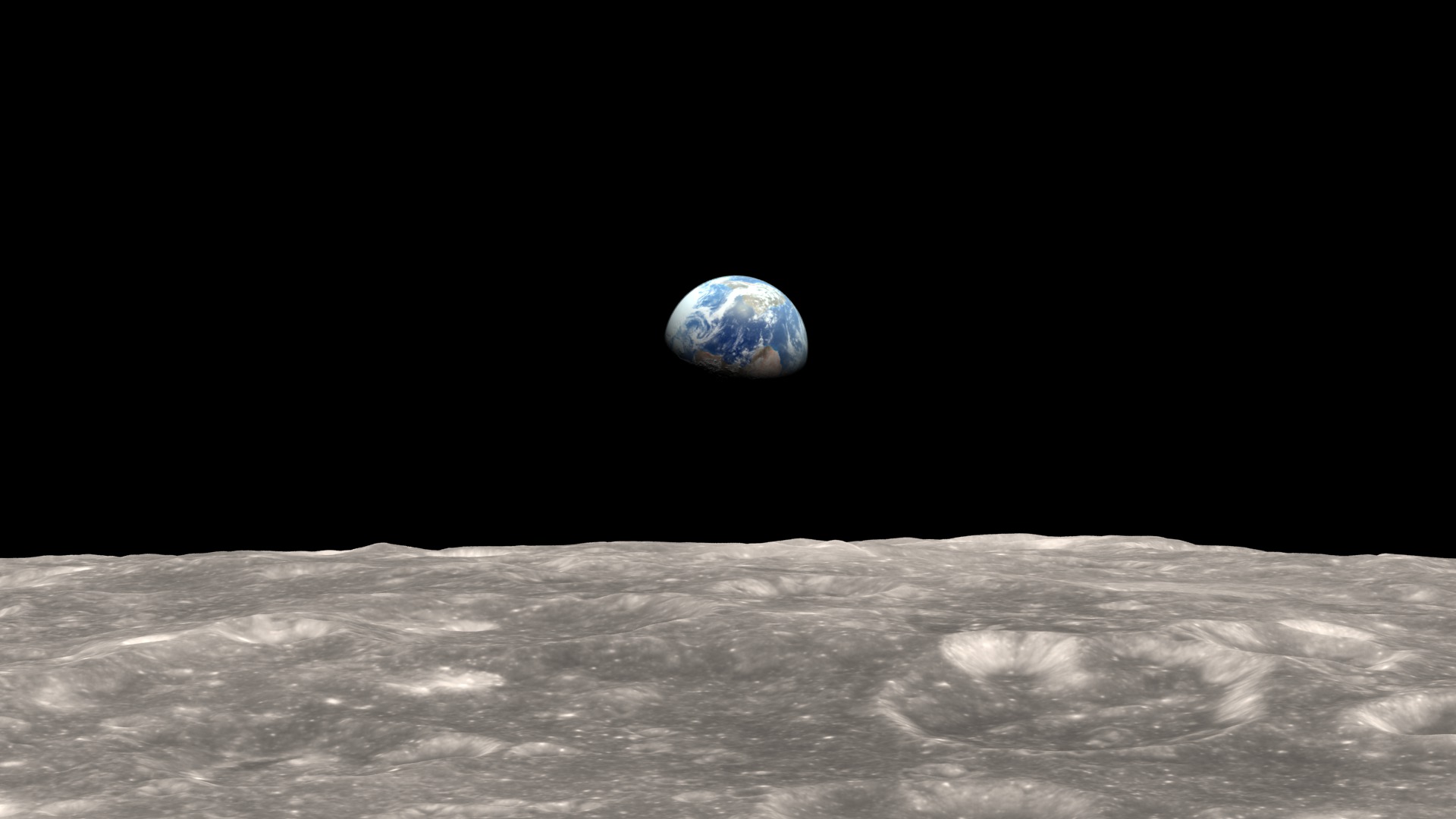 Earthrise - It’s one of the most reproduced space photos of all time, but taking this awe-inspiring image of the Earth rising above the lunar horizon was never actually one of NASA’s mission objectives. Apollo 8 was sent to study and take pictures of the moon’s surface. It was the first time humans had ever laid eyes on the blue planet from the vast blackness of space, and astronaut William Anders snapped the only colour photo of the spectacle.
Earthrise - It’s one of the most reproduced space photos of all time, but taking this awe-inspiring image of the Earth rising above the lunar horizon was never actually one of NASA’s mission objectives. Apollo 8 was sent to study and take pictures of the moon’s surface. It was the first time humans had ever laid eyes on the blue planet from the vast blackness of space, and astronaut William Anders snapped the only colour photo of the spectacle. -
23.
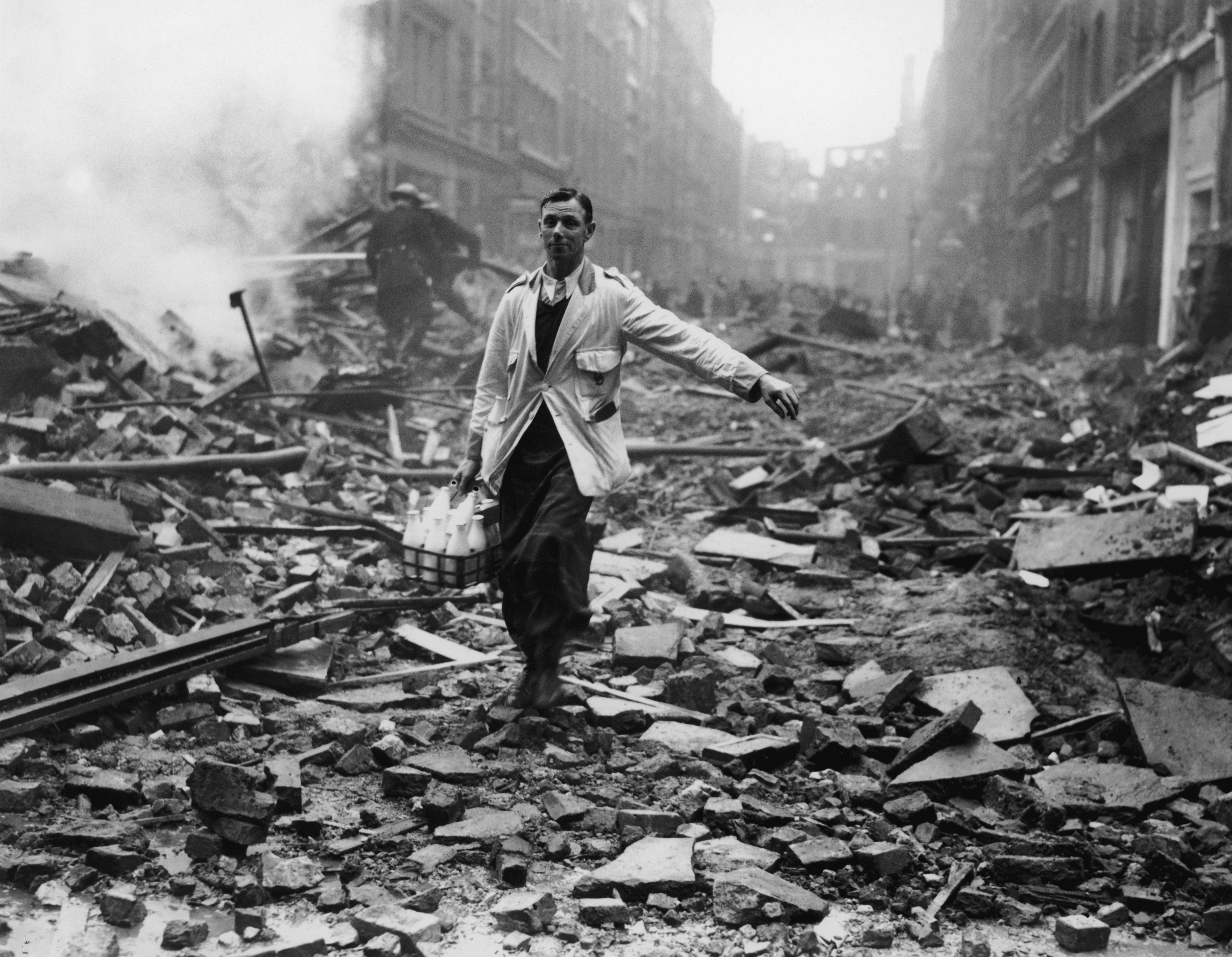 The London Milkman - Taken by Fred Morley during the London blitz on October 9, 1940, this photo portrays a milkman making his rounds on foot despite the devastation around him. Intended to raise spirits by potently displaying the spirit of British stoicism during wartime, the picture was actually staged. Morley’s assistant borrowed a milkman’s outfit and a bottle rack, and Morley found some firefighters for him to pose in front of. The government censors had restricted the publication of anything that might cause panic, but Morley circumvented this by depicting normal life carrying on despite the carnage. It worked, and the photo was published the next day.
The London Milkman - Taken by Fred Morley during the London blitz on October 9, 1940, this photo portrays a milkman making his rounds on foot despite the devastation around him. Intended to raise spirits by potently displaying the spirit of British stoicism during wartime, the picture was actually staged. Morley’s assistant borrowed a milkman’s outfit and a bottle rack, and Morley found some firefighters for him to pose in front of. The government censors had restricted the publication of anything that might cause panic, but Morley circumvented this by depicting normal life carrying on despite the carnage. It worked, and the photo was published the next day. -
24.
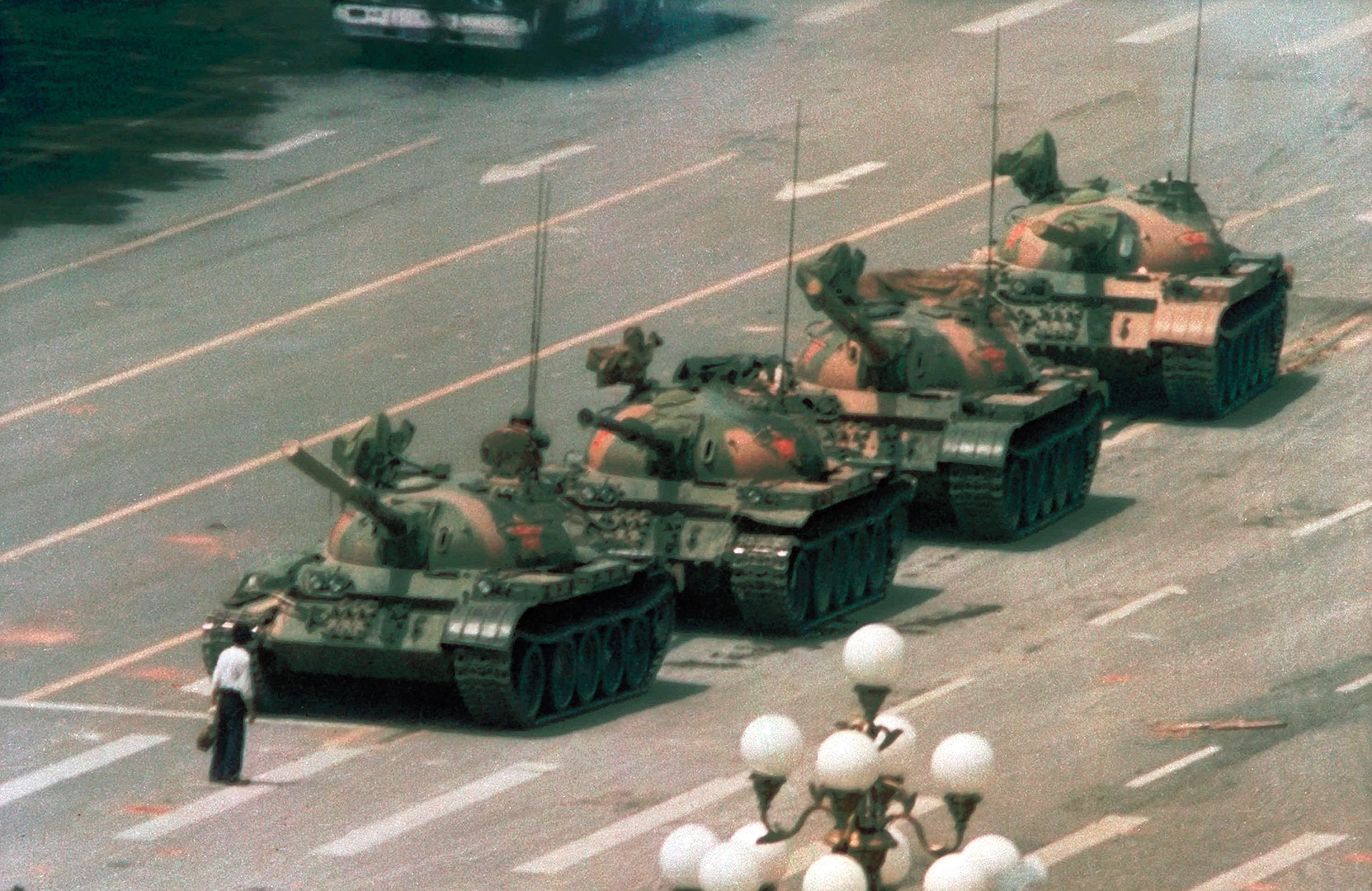 Tank Man - Later becoming a defiant symbol of resistance around the world, Jeff Widener’s iconic photo of a regular man stepping in front of a line of tanks to block their path initially needed to be protected from governmental confiscation. Pulitzer Prize winning photographer Liu Heung-Shing, who was also covering the incident, advised Widener to hide the film in his hotel room after learning about his photos. Widener then went down to the hotel lobby, found a blonde American man with a ponytail and backpack, and paid him to sneak the film past plainclothes police and to the Associated Press. The tank man himself remains unknown.
Tank Man - Later becoming a defiant symbol of resistance around the world, Jeff Widener’s iconic photo of a regular man stepping in front of a line of tanks to block their path initially needed to be protected from governmental confiscation. Pulitzer Prize winning photographer Liu Heung-Shing, who was also covering the incident, advised Widener to hide the film in his hotel room after learning about his photos. Widener then went down to the hotel lobby, found a blonde American man with a ponytail and backpack, and paid him to sneak the film past plainclothes police and to the Associated Press. The tank man himself remains unknown. -
25.
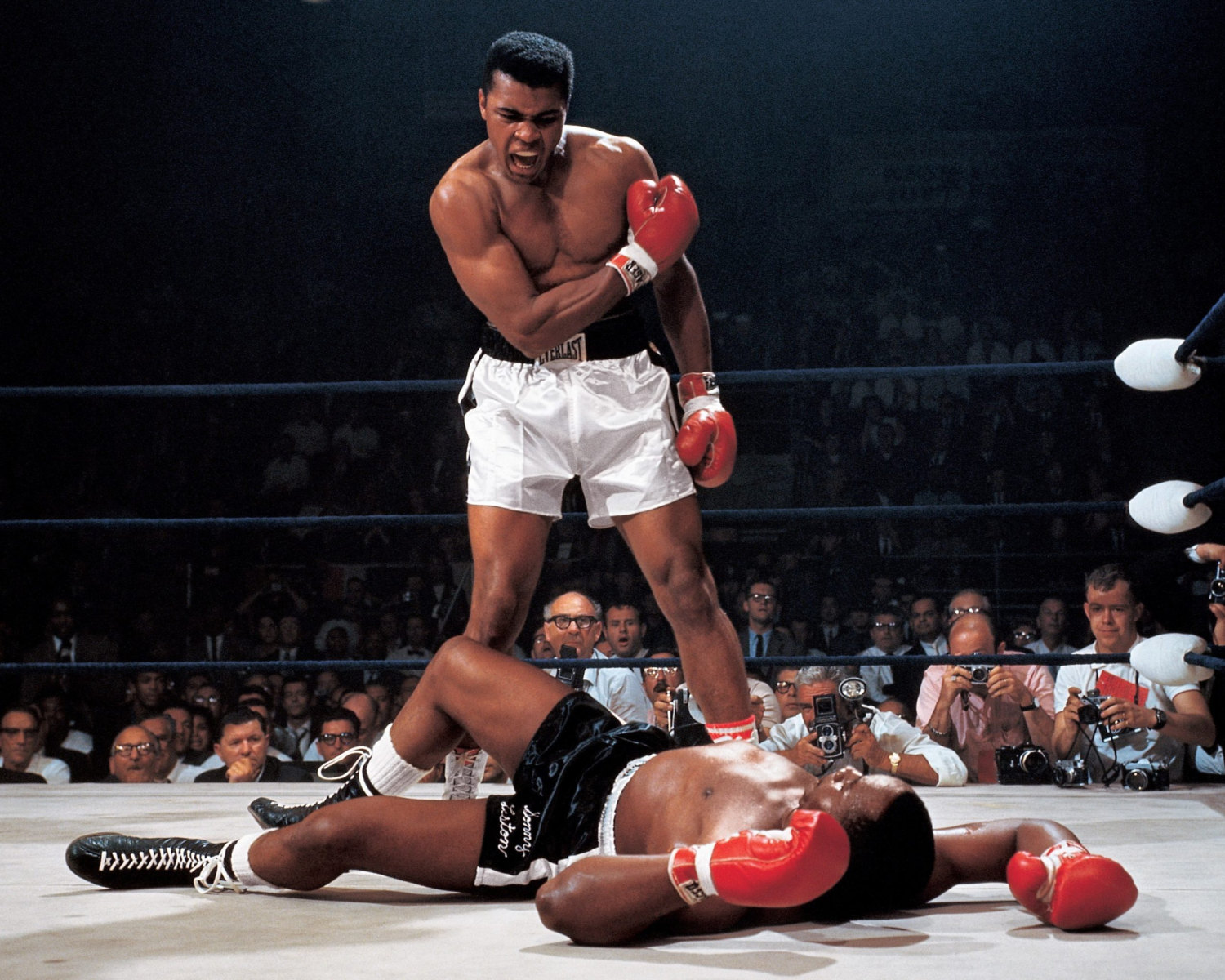 Muhammad Ali vs. Sonny Liston - Sports Illustrated photographer Neil Leifer was in the right place at the right time to snap what is perhaps the greatest sports photo of the 20th century, but he was only there because a senior photographer had arrived before him and essentially forced him to that side of the ring. Leifer was only 22 at the time, and fellow Sports Illustrated photographer Herb Scharfman got there first and pulled rank to claim a prime spot by the judges’ table. Leifer’s seat on the opposite side ended up being perfectly positioned for that historic photo, while Scharfman was stuck shooting toward Ali’s back. Scharfman can be seen in the crowd between Ali’s legs in Leifer’s photo. “It didn’t matter how good Herbie was that day,” Leifer said later. “He was in the wrong seat.”
Muhammad Ali vs. Sonny Liston - Sports Illustrated photographer Neil Leifer was in the right place at the right time to snap what is perhaps the greatest sports photo of the 20th century, but he was only there because a senior photographer had arrived before him and essentially forced him to that side of the ring. Leifer was only 22 at the time, and fellow Sports Illustrated photographer Herb Scharfman got there first and pulled rank to claim a prime spot by the judges’ table. Leifer’s seat on the opposite side ended up being perfectly positioned for that historic photo, while Scharfman was stuck shooting toward Ali’s back. Scharfman can be seen in the crowd between Ali’s legs in Leifer’s photo. “It didn’t matter how good Herbie was that day,” Leifer said later. “He was in the wrong seat.”
The Situation Room - Taken by Pete Souza on the afternoon of May 1, 2011, this image shows President Barack Obama and his national security team crowded into a small conference room in the West Wing’s Situation Room, receiving updates as US forces raided Osama bin Laden’s Pakistan compound and killed the terrorist leader. Photographs of bin Laden’s body have never been released, making Souza’s photo the only public image of one of the defining moments of the war on terror.
25/25
1/25








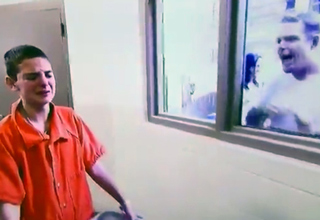
12 Comments